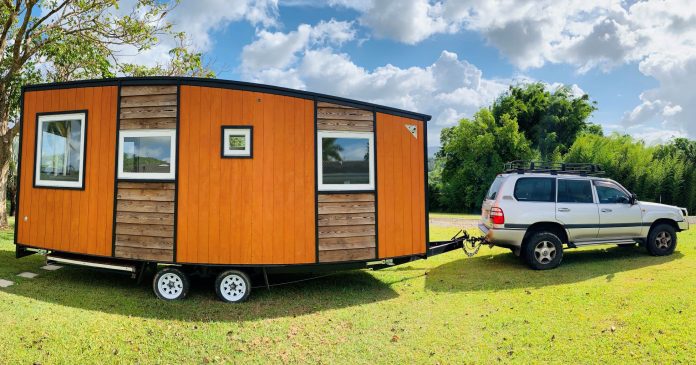Size doesn’t matter, it’s what you do with it that counts. Just ask tiny house owner Jimmy Hirst, who has been living in a high-tech tiny house on wheels in the Sunshine Coast hinterland for the past two years.
The founder of Polkadot Tiny Houses has designed and built a prototype of a self-sufficient, off-grid tiny house that is mobile, generates its own power and water, composts its own waste and could help ease the region’s housing crisis.

It’s 6.5 metres long and 3.7 metres high – a little bigger than a shipping container – and he’s now making an even smaller prototype in Coolum.
“It’s going to be a ten-foot by eight-foot box, built very well and able to be joined to others if you want more space.”
The original prototype is called the Polkadot and accommodates up to three people.
“It doesn’t feel claustrophobic to me,” he says. “I feel it’s too big for me on my own. It has a queen-size bed and a generous single bed that can be put together at the other end of the tiny house. I had my ex-girlfriend sleeping at the other end after we’d broken up and we didn’t even notice each other because there are sliding doors to block the rooms off. Each end is almost independent and the other person doesn’t really feel encroached upon. That’s rare for tiny houses.”
What separates the Polkadot from other tiny houses is the level of built-in technology. Designed with senior, single women in mind, it features five security cameras that can be viewed from anywhere in the world, Crimsafe doors, a wifi cupboard containing a broadband modem, a smart home hub with Google Assistant and DVR security system and a smart lighting system that recreates scenes such as sunrises and sunsets.

Its sustainability features include an air-to-water generator that pulls 33 litres of water out of the air a day, 2.4 kilowatts of solar panels on the roof, with a four-kilowatt inverter and four kilowatts worth of batteries. It also has a rechargeable vacuum cleaner – he says it takes two minutes to clean – an indoor hydroponic garden, a full size 12-volt fridge, full gas stove and oven, full size laundry sink, full size shower, composting toilet and three separate living areas.
With tiny houses being touted as a potential solution to the current housing affordability and homelessness crisis, Mr Hirst says his prototype solves some of the problems currently facing the tiny house movement, including affordability.
“Most tiny houses are in the $80,000 to $110,000 bracket and we’re aiming to build ours for under $50,000.”
Do you have an opinion to share? Submit a Letter to the Editor with your name and suburb at Sunshine Coast News via: news@sunshinecoastnews.com.au
While Mr Hirst is currently paying some friends $80 per week to park his tiny house on their property just outside Maleny, he says he could park it anywhere you could park a caravan or a bus.
“If you understand the town plan the building codes, you can do pretty much whatever you like, but you need to do your homework or have someone like us to do the homework for you. There are safety aspects, legal aspect and neighbours to consider.
“I’ve generally gone onto properties where I know the owners, but there are tonnes of opportunities for people with tiny houses to park anywhere they want to.”

Sunshine Coast residents concerned about the current homelessness crisis are beginning to advertise their properties on social media as available for people who are in need of somewhere long-term to park their caravans, trailers or tiny homes.
Sunshine Coast Council specifies that vehicles permanently converted to tiny houses are subject to the same planning, building and plumbing laws that apply to a permanent building. However, a vehicle capable of being registered, such as a caravan or trailer, is not classed as a tiny house.
Help keep independent and fair Sunshine Coast news coming by subscribing to our free daily news feed. All it requires is your name and email. See SUBSCRIBE at the top of this article
Where a tiny house is proposed in addition to an existing dwelling house on the same property, it is referred to as a secondary dwelling under the Sunshine Coast Planning Scheme 2014.
Those wishing to use a vehicle for temporary accommodation need to obtain a council local law permit and the temporary use is subject time limits.
Andrew Powell, the State member for Glass House, has expressed concern about the current housing issue and believes tiny houses are a possible solution to growing homelessness on the Sunshine Coast.
“The state and council can work together to amend laws to allow tiny homes to be put into rural and residential settings,” he told Sunshine Coast News. “That would offer emergency housing for a lot of people quickly.
“Tiny houses are not a long-term solution for larger families, but they they are a good short-term fix [for homelessness] and we need to be looking at tiny homes and other solutions.
“To that end I’ve been working with Maleny Neighbourhood Centre and other advocates. We know what has to change in the legislation – there are references in the planning schemes at both the council and state level. How long could that take? How long is a piece of string?”
The Tiny Houses & Tiny Villages: 2.5 Planning Summit will be held on Saturday, May 15, at Maleny RSL for key stakeholders and government representatives. Due to COVID restrictions, the event is invite only. If you are interested in attending, visit polkadot.org.au.





